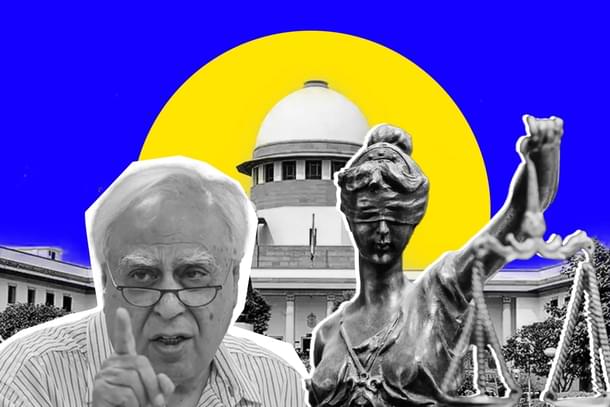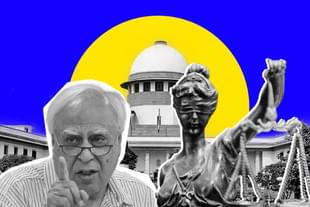Ideas
Kapil Sibal Wants Live Streaming Of Court Proceedings To End. Why He Seems Right But Isn’t
Abhishek Kumar
Sep 27, 2024, 04:53 PM | Updated 05:30 PM IST
Save & read from anywhere!
Bookmark stories for easy access on any device or the Swarajya app.


During a hearing on the Kolkata RG Kar Hospital murder-rape case, senior lawyer Kapil Sibal requested the Supreme Court to stop live proceedings, claiming reputational hazards.
Sibal is already facing public ire for representing the Mamata Banerjee government in what the general public deems an open-and-shut case of the government being hand in glove with those accused of the heinous crime.
One of the points of criticism against Sibal was that he was laughing in one of the hearings, a charge he has vehemently denied. However, by the time the denial arrived, a clip of Solicitor General Tushar Mehta objecting to the alleged ‘laugh’ had already gone viral.
Chief Justice D Y Chandrachud did not accede to Sibal's demand, but such a request from the sitting president of the Supreme Court Bar Association (Sibal) puts a spotlight on the live streaming of court proceedings.
Days after Sibal’s demand, a video of Karnataka High Court judge Justice V Srishanandan went viral. In the video, he is heard referring to Muslim-dominated areas as 'Pakistan'. The Supreme Court took suo motu cognisance of it, and the judge had to apologise.
Meanwhile, the Advocates’ Association of Bengaluru jumped into the issue and demanded that Karnataka High Court Chief Justice N V Anjaria stop live streaming for a few days. This was not accepted in totality, but the court did come up with a note titled 'Prohibitions and Restrictions on Usage of the Recording or Live Stream'.
The note reiterates that unauthorised recording, sharing, or dissemination of live-streamed proceedings and archival data on social media and messaging platforms are prohibited.
These guidelines were supposedly framed to allay the criticism of live streaming of court proceedings.
The Negatives Of Live Streaming
For one, live streaming makes the judiciary potentially vulnerable to public sentiment. Judges are not supposed to follow public sentiment but decide cases based on legal and constitutional principles alone.
The process of adjudication may at times involve asking inconvenient and politically incorrect questions to parties. That could present an opportunity for politically active lawyers (like Sibal) to grandstand.
Given the capacity for filibustering on the part of lawyers, such exchanges could impact the dispensation of justice.
Secondly, the tendency in some lawyers and judges to play to the galleries is also a major concern.
Rather than the substance of argument, law, and logic, courtroom exchanges, when live streamed, tend to run the risk of turning into a power struggle between the judge and the advocate. At times, the advocate may even try to show their client that they can even pin the judge in an argument.
A third fear is that video clips of these exchanges would be removed from their context and used arbitrarily by social media influencers and channel owners to gain virality. That judicial proceedings can become material for popular culture memes does little to inspire confidence in the courts.
How Did Live Streaming Begin?
The Supreme Court authorised live streaming of court proceedings in the Swapnil Tripathi case around 2018. Four years later, live streaming of the Chief Justice’s court in the Supreme Court began. High Courts also joined in.
Once live streaming began, all of the aforementioned fears started to materialise. Accusations of both judges and advocates playing to the gallery have surfaced.
In one video, a Patna High Court judge and an advocate started to argue over the language used in court. In the same High Court, an Indian Administrative Service (IAS) officer was scolded for not wearing proper attire.
Another video surfaced where a judge was seen asking a person who did not do their job properly, “Have you got your job due to reservation?”
These videos did not only go viral. Snippets of full hearings were edited, given a funny or eye-catching caption, and uploaded. These days, videos from family courts particularly go viral and are used by advocates to gain the audience's attention.
Judges have said they are cognisant of the impact of their utterings on social media. One of them is the Chief Justice of India himself.
The counterargument is that judicial training is good enough to immunise court officers from the temptations of virality.
But one thing is certain: live streaming is leading to more and more controversies. “Many advocates faced inconvenience because of the video clippings of the court proceedings on YouTube and other social media. They projected lawyers in a poor light,” said the Bengaluru Advocates’ Association.
To this extent, Sibal is right, and his demand for shutting down live streaming cannot be dismissed. The fear, though, is that the demand will do more damage than it seeks to control.
Sibal is himself well-placed to understand that reputational hazard is something every public figure has to deal with. By virtue of being a politician too, he knows the charges he is facing can be countered by more words and not less, so closing down live streaming won’t help his cause.
If Parliament Can Be Live Streamed, Why Not Courts?
One answer to this question is that the Parliament consists of two houses whose primary objective is to express the will of the people that elected its members.
The objective of the judiciary is not to reflect popular sentiment but to solely adjudicate on questions of, and interpret, law. If any practice, new or old, is found to be obstructive in the performance of that task, that practice must be discontinued.
At the same time, the judiciary, even with all its backlogs and issues, is one of the pillars of Indian democracy. Any institution in that role should ideally be transparent in its workings. For that reason, live streaming of court proceedings should continue.
There will be people seeking to misuse the facility, but the institution will eventually learn to deal with them. Shutting down the process won’t help.
As Chandrachud himself said in the Swapnil Tripathi case, “Sunlight is the best disinfectant.”
Abhishek is Staff Writer at Swarajya.




